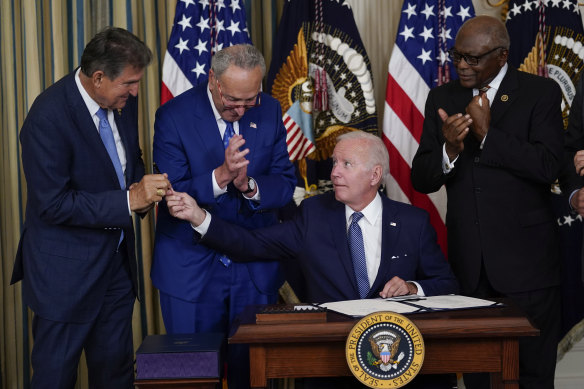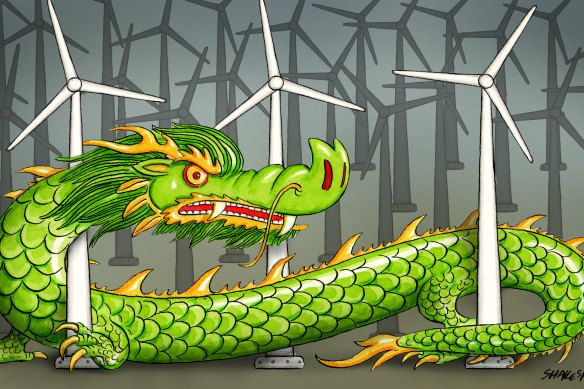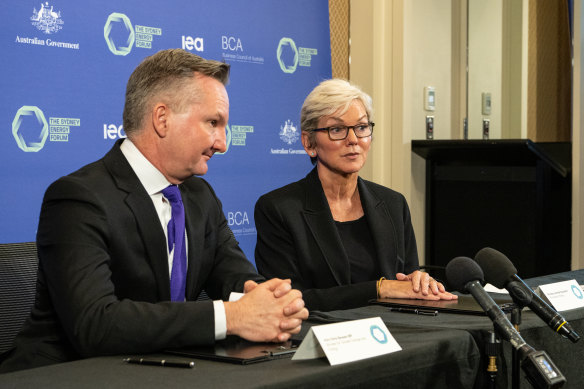Climate activists and scientists the world over breathed deeply in relief this week when President Joe Biden signed into law the Inflation Reduction Act, as America’s biggest-ever package of climate actions had been rebranded while it was wrestled forcefully through the Senate.
“It’s law,” said Biden at the White House on Tuesday. “This bill is the biggest step forward on climate ever.”
President Joe Biden hands the pen he used to sign the Democrats’ landmark climate change and health care bill to Senator Joe Manchin. Also pictured is Senate Majority Leader Chuck Schumer and Majority Whip James Clyburn.Credit:AP
And the scope of the package is extraordinary. Its various measures will channel $US370 billion ($535 billion) into programs that, if successful, will see the creation of 60 gigawatts of new renewable energy capacity a year, doubling the amount deployed last year.
But in focusing on the future plans of America, the world risks missing what is already going on in China, where a green revolution is already sweeping the economy.
In the world’s popular imagination, China is a machine built on coal. At the COP26 climate talks in Glasgow in November last year, China – along with Australia and India – declined to sign a pledge to phase out coal use. In the wake of the pandemic, it stimulated its economy by ramping up coal production so much that climate observation satellites detected new plumes of methane emissions leaking from mines across Inner Mongolia.
For years China’s reliance on coal has been used as a rhetorical device by those in the West opposed to taking effective climate action. It was the excuse Donald Trump used when he abandoned the Paris Agreement in 2017. “China will be allowed to build hundreds of additional coal plants,” Trump said. “So, we can’t build the plants, but they can, according to this agreement.”
IllustrationCredit:John Shakespeare
But the coal haze has obscured a more crucial truth about China’s energy expansion. If pending US efforts on renewable energy are extraordinary, the revolution under way in China is truly staggering. Last year the US boasted that it was on track to deploy about 30 gigawatts of new renewables. In China, the figure could be as hight as180 gigawatts. Last year China alone accounted 46 per cent of the world’s total new construction of renewable energy infrastructure.
Last week Bloomberg NEF reported that China’s renewables investment for the first half of 2022
included large-scale solar totaling $US41 billion – up 173 per cent from the year before – and investment in new wind projects increasing by 107 per cent year-on-year to $US58 billion.
This not a product of altruism. President Xi Jinping is doing it because he intends that China dominate the critical industries of the future.
As international energy analyst Tim Buckley puts it, while China leads the world in coal use, it also leads the world in “wind and solar installation, in wind and solar manufacturing, in electric vehicle production, in batteries, in hydro, in nuclear, in ground heat pumps, in grid transmission and distribution, and in green hydrogen. They literally lead the world in every zero emissions technology today.”
And though China has not yet ended its own coal addiction, it is making serious moves to curtail the industry. Last year Xi surprised the world with an announcement at the United Nations that it would stop funding offshore coal power stations, effectively knocking out 70 per cent of the flow of global investment into the industry.
“China will step up support for other developing countries in developing green and low-carbon energy, and will not build new coal-fired power projects abroad,” Xi said in a pre-recorded video. Since then, no new coal finance has flowed into China’s vast global Belt and Road infrastructure projects.
And underlying the pivot from fossil to green, the planet’s largest battery manufacturer – CATL of
China – this week announced it would build the world’s largest new battery-making plant in
Hungary, an amazing 100GWh of annual battery capacity costing US$7 billion, to supply Europe’s
booming EV market.
The impetus behind China’s green ambition is, reasonably enough, self-interest.
Richard McGregor, a senior fellow at the Lowy Institute, notes that, like other countries, China has identified the pressing threat of climate change. Just this week, factories across Sichuan province – including makers of solar panels, cement and urea – have been forced to close or reduce production after power was rationed due to hydropower shortages caused by drought.
China’s rivers are running as dry as those across parts of Europe and North America, due to the infernal heat of the northern summer. And while this summer will wane, it is not clear that the threat of water shortages will.
The retreat of glaciers in western China is expected to reduce annual spring flows into the nation’s system of rivers. This is why one of the largest infrastructure projects in human history is China’s so-called South-North Water Transfer Project.
“There are no climate deniers in China, or at least no climate deniers who are allowed to have a voice,” McGregor says. “You can tell that very easily because China’s official media is not full of people denying climate change. The Propaganda Ministry doesn’t allow voices which question science.”
But there is more to it than that.
“They are doing this because they want to dominate the investment, the employment, the technology, leadership and the export opportunities that this entails for their economy,” Buckley says. “And they see all of these industries as global growth sectors.”
McGregor agrees: “In China, climate policy is industry policy.”
But that is making Western policymakers nervous. Last month, Biden’s Energy Secretary Jennifer Granholm, attended a conference in Sydney alongside Australian Energy Minister Chris Bowen and the International Energy Agency director Fatih Birol. The conference was held in the bleak shadow of Vladimir Putin’s invasion of Ukraine and the energy crunch it caused across Europe, which had allowed itself to become reliant on Russian gas.
Federal Energy Minister Chris Bowen and US Energy Secretary Jennifer Granholm speak in Sydney on July 12, 2022.Credit:Flavio Brancaleone
A key message was a warning about China’s dominance not only of the deployment of renewable technology and its manufacture, but even the production of its base ingredients, such as polysilicon used to make photovoltaic solar cells, and the processing of critical minerals and lithium.
Western leaders worry that just as Europe allowed itself to be blackmailed by an energy giant in Putin, they might be setting themselves up for the same problem with Xi in a decarbonised world. Far from fretting that China is stuck in the coal era, they fear it will dominate the renewable future.
Granholm told the conference the world needed to make sure “we are not under the thumb of petro-dictators … [or] the thumb of those who strategically would like to control aspects of the supply chain”. At a press conference, she added her concern China was “big-footing” renewables technology and supply chains. “From an energy security point of view, it is imperative that nations that share the same values develop our own supply chains, not just for the climate, which of course is very important, but for our own energy security.”
Birol said 80 per cent of the world’s solar cells were produced by China and that by 2025 it would be about 95 per cent. “For the entire world to rely on one single country for a technology we all need is something we need to think about from an energy security perspective,” he said. “One province [in China] is responsible for about 40 per cent of global production and two factories for about 20 per cent. What happens if there is a fire?”
What he left unsaid was that there need not be a fire in a factory for supply lines from China to dry up. Another speaker was the chairman of Japan’s Institute of Energy Economics, Tatsuya Terazawa, who explained how his nation’s supply of critical minerals and rare earths for batteries and components for wind turbines ended suddenly after a collision between a Chinese fishing boat and a Japanese Coast Guard vessel. That prompted China to end rare earth sales to Japan.
“Frankly, we were not aware that we were so dependent on Chinese rare earths,” said Terazawa. “The embargo almost paralysed entire industrial activities, and the prices of rare earths skyrocketed quickly.”
About a fortnight after the Sydney conference ended, US House Speaker Nancy Pelosi visited Taiwan, predictably enough infuriating China. Among China’s responses was the announcement that it would end climate discussions with the US.
For years climate co-operation between the US and China had been both serious and consequential. There would be no Paris Agreement, for instance, without the talks held between US climate envoy John Kerry and China’s chief climate diplomat Xie Zhenhua.
The fact China and the US had been able to quarantine climate from their increasing rivalry was important to a world nervously eyeing the tensions between the two superpowers.
Li Shuo, senior global policy adviser at Greenpeace China, says a crucial contribution China has made is not just the billions of tonnes of greenhouse gases its own deployment of green tech has avoided, but its success in driving down the cost of the technology globally. It might make absolute geopolitical sense for the rest of the world to develop its own supply chains, but he fears it is not clear that it can achieve its decarbonisation goals without China.
“I think the jury is very much still out on this,” Li told the Herald this week. “In fact, we’re only at the very beginning of this decoupling, so I don’t think we know the answer to that question.
“Only time will tell, but the stakes are high.”
The Opinion newsletter is a weekly wrap of views that will challenge, champion and inform your own. Sign up here.
Most Viewed in Environment
From our partners
Source: Read Full Article










